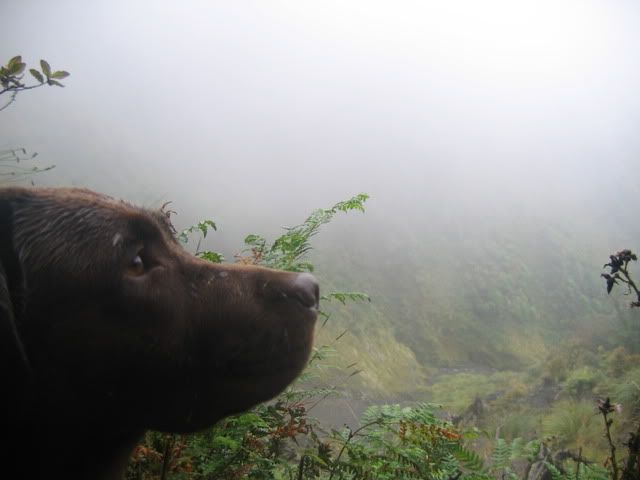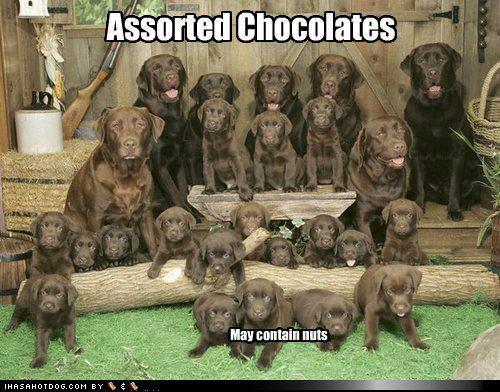Ive only ever owned black labs but as far as i can see from mates dogs etc its all aboit the dog, also as they are same breed it wouldnt make any sense, like yellow labs can have black pups,
Welcome guest, is this your first visit? Create Account now to join.
Welcome to the NZ Hunting and Shooting Forums.
Search Forums
User Tag List
+ Reply to Thread
Results 61 to 67 of 67
Thread: Black Lab Temperment
-
12-12-2012, 04:17 PM #61Member

- Join Date
- Dec 2012
- Location
- Southland
- Posts
- 3
-
-
14-12-2012, 03:53 PM #62
-
14-12-2012, 04:03 PM #63
Know a couple that have inherited their sons chocolate lab from their son while he is overseas. They reckon it has no retrieve drive, and no interest in water, which I thought were two things you couldn't ever breed out of a lab. Amazes me what you can lose in such a short time by selecting for the wrong things, ie. colour alone
-
14-12-2012, 04:09 PM #64
-
16-12-2012, 01:35 PM #65
Firstly here is some info on how genes influence color.... from wikipedia.
Colour
The three primary color varieties of the Labrador Retriever
Labrador Retrievers are registered in three colors:[20] black (a solid black color), yellow (anything from the color that some breeders sell as white or cream to "fox-red"), and chocolate (medium to dark brown). Some dogs are sold as "silver" pure-bred Labradors, but purity of those bloodlines is currently under dispute. Major kennel clubs around the world allow Silver Labradors to be registered, but not as 'Silver'. The Kennel Club (England) requires that they be registered as 'Non-recognized'. The parent club for the Labrador Retriever in the USA (the LRC) states publically that 'There is no genetic basis for the silver gene in Labradors'.[23] Occasionally Labradors will exhibit small amounts of white on their chest, paws or tail, and rarely a purebred Lab will exhibit brindling (stripes) or tan points similar to a Rottweiler.[24] These markings are a disqualification for show dogs but do not have any bearing on the dog's temperament or ability to be a good working or pet dog.
Puppies of all colors can potentially occur in the same litter. Color is determined primarily by three genes. The first gene (the B locus) determines the density of the coat's eumelanin pigment granules, if that pigment is allowed: dense granules result in a black coat, sparse ones give a chocolate coat. The second (E) locus determines whether the eumelanin is produced at all. A dog with the recessive e allele will produce only phaeomelanin pigment and will be yellow regardless of its genotype at the B locus. The genes known about previously[25] have had their number increased by the introduction of the K locus, where the dominant "black" allele KB is now known to reside.[26] Black or chocolate Labradors therefore must have the KB allele. Yellow Labradors are determined at the E locus, so the K locus is irrelevant in determining their color. Variations in numerous other genes control the subtler details of the coat's coloration, which in yellow Labradors varies from white to light gold to a fox red. Chocolate and black Labradors' noses will match the coat color.
According to a 2011 study, 13 out of 245 Labradors studied were heterozygous for the M264V mutation responsible for the melanistic mask, and one was homozygous. Within the breed, this trait is not visible.[27]
Nose and skin pigmentation
Because Labrador coloration is controlled by multiple genes, it is possible for recessive genes to emerge some generations later and also there can sometimes be unexpected pigmentation effects to different parts of the body. Pigmentation effects appear in regard to yellow Labradors, and sometimes chocolate, and hence the majority of this section covers pigmentation within the yellow Labrador. The most common places where pigmentation is visible are the nose, lips, gums, feet, tail, and the rims of the eyes, which may be black, brown, light yellow-brown ("liver", caused by having two genes for chocolate),[28] or several other colors. A Labrador can carry genes for a different color, for example a black Labrador can carry recessive chocolate and yellow genes, and a yellow Labrador can carry recessive genes for the other two colors. DNA testing can reveal some aspects of these. Less common pigmentations (other than pink) are a fault, not a disqualification, and hence such dogs are still permitted to be shown.[28] The intensity of black pigment on yellow Labradors is controlled by a separate gene independent of the fur coloring.[28] Yellow Labradors usually have black noses, which may gradually turn pink with age (called "snow nose" or "winter nose"). This is due to a reduction in the enzyme tyrosinase which indirectly controls the production of melanin, a dark coloring. Tyrosinase is temperature dependent—hence light coloration can be seasonal, due to cold weather—and is less produced with increasing age two years old onwards. As a result, the nose color of most yellow Labradors becomes a somewhat pink shade as they grow older.[28]
A coloration known as "Dudley" is also possible. Dudleys are variously defined as yellow Labradors which have unpigmented (pink) noses (LRC), yellow with liver/chocolate pigmentation (AKC), or "flesh colored" in addition to having the same color around the rims of the eye, rather than having black or dark brown pigmentation.[14][28] A yellow Labrador with brown or chocolate pigmentation, for example, a brown or chocolate nose, is not necessarily a Dudley, though according to the AKC's current standard it would be if it has chocolate rims around the eyes (or more accurately of the genotype eebb). Breed standards for Labradors considers a true Dudley to be a disqualifying feature in a conformation show Lab, such as one with a thoroughly pink nose or one lacking in any pigment along with flesh colored rims around the eyes. True Dudleys are extremely rare.[28][29] c
Breeding in order to correct pigmentation often lacks dependability. Because color is determined by many genes, some of which are recessive, crossbreeding a pigmentation non-standard yellow Labrador to a black Labrador may not correct the matter or prevent future generations carrying the same recessive genes. For similar reasons, crossbreeding chocolate to yellow Labradors is also often avoided.
Ok so the relevance is this... when the chocolate became extremely popular as a companion dog many breeders breeding for money produced only chocolates. They did not breed for any quality other than to produce the chocolate coloring... with no attention to the qualities most of us seek in a gundog many of these traits disappeared because in order to keep up with the demand the choccies were continually and successively bred to choccies creating more and more useless choccies.
Now you are absolutely right that color is only color and they are all the same breed and if the same attention is paid to reproducing the right genetics and taking what colors come then there should be little difference in performance. Along these lines one of the nicest Labs i ever saw run was a chocolate. It was an exception. I do not believe there is bugger all difference in blacks or yellows.
The only reason chocolates have reduced to their current standing is poor breeding practices in producing them, there is no reason why it should have happened except money. Those who own a chocolate will get offended by these facts but shouldn't, just take solace in the only two options you have available to you... 1) You over-rate your dog's abilities or 2) You got one of the good ones. If it really is a good one, keep it in the gene pool... the chocolates need all the help they can get.
or 2) You got one of the good ones. If it really is a good one, keep it in the gene pool... the chocolates need all the help they can get.
In my professional opinion of all of the accepted gundog breeds currently of common use in the field in NZ if I was to predict which would be most likely to produce a total dud that even training won;t help, it will be a chocolate lab. That's after working with a few dozen or more of them. But you can always hold out for that one in a hundred like I mentioned above.
Hope that clarifies it for you.
Tags for this Thread
Welcome to NZ Hunting and Shooting Forums! We see you're new here, or arn't logged in. Create an account, and Login for full access including our FREE BUY and SELL section Register NOW!!





 7Likes
7Likes LinkBack URL
LinkBack URL About LinkBacks
About LinkBacks



 Reply With Quote
Reply With Quote





Bookmarks